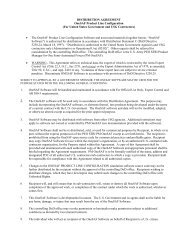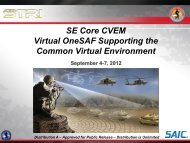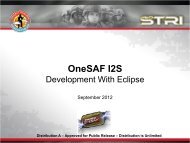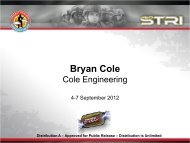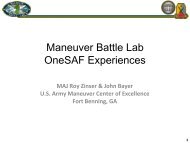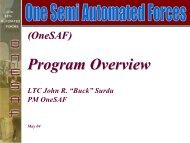Army Materiel Systems Analysis Activity - OneSAF Public Site
Army Materiel Systems Analysis Activity - OneSAF Public Site
Army Materiel Systems Analysis Activity - OneSAF Public Site
You also want an ePaper? Increase the reach of your titles
YUMPU automatically turns print PDFs into web optimized ePapers that Google loves.
<strong>Army</strong> <strong>Materiel</strong> <strong>Systems</strong> <strong>Analysis</strong> <strong>Activity</strong><br />
40 Years of<br />
Excellence in <strong>Analysis</strong><br />
<strong>OneSAF</strong> Survivability Suite (OS2) Overview<br />
Scott Johnson<br />
410-278-2036<br />
scott.c.johnson98.civ@mail.mil<br />
Approved for <strong>Public</strong> Release; Distribution is Unlimited.<br />
1
• Introduction<br />
• Definitions<br />
• OS2 Capabilities<br />
• OS2 Design<br />
• OS2 Verification<br />
• Future Development<br />
• Future Utility<br />
• Summary<br />
Agenda<br />
2
Introduction<br />
• Background<br />
– US <strong>Army</strong> <strong>Materiel</strong> <strong>Systems</strong> <strong>Analysis</strong> <strong>Activity</strong> (AMSAA)<br />
Other Than Armor (OTA) Survivability Team is<br />
dedicated to providing the United States <strong>Army</strong> with<br />
analysis, data and tools to support decisions regarding<br />
OTA survivability technologies<br />
– Modeling & Simulation (M&S) tools exist to evaluate<br />
individual survivability technologies but limited<br />
capability exists to address survivability technologies<br />
at the item level<br />
– AMSAA conducted a study to determine the best<br />
approach to developing a survivability suite analysis<br />
tool and decided to develop this tool with <strong>OneSAF</strong>, a<br />
composable force level simulation<br />
• Objective<br />
– Build a simulation for evaluation of OTA survivability<br />
technologies to support item level analysis<br />
• Purpose<br />
– Inform the <strong>OneSAF</strong> community of OS2‟s capabilities,<br />
design and future utility<br />
M&S Hierarchy<br />
Theater<br />
Force-on-<br />
Force<br />
Few-on-Few<br />
One-on-One/Few<br />
Engineering<br />
AMSAA intends to bridge the gap between engineering<br />
level and force-on-force level models<br />
3
Definitions<br />
• An Other-Than-Armor (OTA) technology is any technology that increases platform and<br />
crew survivability and is not baseline or add-on ballistic armor<br />
• A Defensive Aid Suite (DAS) is a subset of OTA technologies designed to prevent a<br />
munition, once launched, from impacting the platform or to reduce the resulting<br />
penetration when a munition impact does occur<br />
• An Active Protection System (APS) is a DAS technology that relies on the detection of<br />
an incoming munition to trigger a sequence of events designed to eliminate munition<br />
impact or reduce munition lethality on the protected platform<br />
• A Passive Protection System (PPS) is a DAS technology that does not rely on the<br />
detection of an incoming munition and accept munition impact while reducing munition<br />
lethality on the protected platform<br />
Survivability “Onion”<br />
See-Understand-Act<br />
Avoid Detection<br />
Avoid Acquisition<br />
Survivability Taxonomy<br />
Avoid Hit,<br />
Penetration,<br />
Kill<br />
OTA<br />
Avoid Hit<br />
Avoid Penetration<br />
DAS<br />
Non-Lethal<br />
Avoid<br />
Kill<br />
APS<br />
PPS<br />
4
OS2 Capabilities<br />
• Components of OS2<br />
– Enhanced and added<br />
representation of threat<br />
munitions<br />
• Mobility<br />
• Guidance<br />
• Designation<br />
– Enhanced and added<br />
representation of DAS<br />
components<br />
• Sensors<br />
• Controller<br />
• Countermeasures (CM)<br />
• OS2 Development Status<br />
– Iteration One<br />
Munition Sensor Countermeasure<br />
SACLOS Tracking,<br />
Guidance and Flyout<br />
• Completed Spring 2008<br />
• Integrated into <strong>OneSAF</strong> v2.5<br />
– Iteration Two<br />
Missile Warning<br />
Receiver (MWR)<br />
Infrared<br />
Countermeasure<br />
(IRCM)<br />
• Completed Spring 2010<br />
• Expected integration into <strong>OneSAF</strong> v6.0<br />
Munition Sensor Countermeasure<br />
Munition<br />
Fired<br />
Sensor 1<br />
Sensor 2<br />
Controller<br />
CM 1<br />
CM 2<br />
Unguided Direct Fire<br />
Flyout (RPG, KE)<br />
Detection and<br />
Tracking Radar<br />
Hard-Kill APS<br />
DAS<br />
Munition Sensor CM<br />
Repository<br />
5
OS2 Iteration One Design<br />
New model using<br />
direct fire delivery<br />
accuracy data on tick<br />
Designation<br />
Emission<br />
IRCM<br />
CM<br />
Capability<br />
Designation<br />
Capability<br />
Target<br />
Designation<br />
Designation<br />
Manager<br />
Emission<br />
Manager<br />
Intel<br />
Perception<br />
Target List<br />
B.B.<br />
HASC<br />
Weapon<br />
Controller<br />
B.B.<br />
MWR<br />
Target Entity<br />
Vulnerability<br />
Threat Entity<br />
Creates<br />
Physical Component<br />
Behavioral Component<br />
OS2 Development<br />
Mobility<br />
This physical model contains the<br />
Guidance PKAD, IRCM PKAD and<br />
CLOS Mobility PKAD<br />
Detonate<br />
B.B.<br />
Threat Munition<br />
Fuze<br />
Event<br />
Router<br />
Detonation<br />
B.B. – Blackboard<br />
CM – Countermeasure<br />
HASC – Hit Avoidance Suite Controller<br />
IRCM – Infrared Countermeasure<br />
MWR – Missile Warning Receiver<br />
PKAD – Physical Knowledge Acquisition Document<br />
6
OS2 Iteration Two Design<br />
Threat Entity<br />
B.B.<br />
MFRFS/<br />
MWR<br />
Target Entity<br />
Perception<br />
GV<br />
Vulnerability<br />
Dismounted<br />
Infantry<br />
B.B.<br />
Weapon<br />
Controller<br />
Intel<br />
B.B.<br />
Target List<br />
SR/LR<br />
CM<br />
*<br />
IC<br />
Vulnerability<br />
Sensor<br />
Capability<br />
Controller<br />
CM<br />
Capability<br />
*<br />
Creates<br />
Physical Component<br />
Behavioral Component<br />
OS2 Development<br />
Threat Munition<br />
Mobility<br />
Detonate<br />
Detonate<br />
B.B.<br />
EFM<br />
Vulnerability<br />
Fuze<br />
Detonation<br />
Event<br />
Router<br />
Detonation<br />
* Represents<br />
the ability to<br />
model fratricide<br />
B.B. – Blackboard<br />
CM – Countermeasure<br />
GV – Ground Vehicle<br />
EFM – Enhanced Fragment Model<br />
IC – Individual Combatant<br />
SR/LR – Short Range/Long Range<br />
MFRFS – Multi Function Radio<br />
Frequency System<br />
MWR – Missile Warning Receiver<br />
7
OS2 Verification<br />
• Unit Testing<br />
– Focused on single instant in time<br />
– Examined functional areas developed independent of each<br />
other to expose data lookup and algorithm/logic<br />
implementation errors<br />
– Performed side by side comparison of AMSAA‟s expected<br />
versus simulation actual results<br />
• System Integration Testing<br />
– Focused over life of a single engagement<br />
– Examined functional areas developed independent of each<br />
other to expose a broader range of errors<br />
– Analyzed and visualized results to ensure trends met<br />
expectations<br />
• Mock Classified <strong>Analysis</strong> (Iteration 1)<br />
• Timeline <strong>Analysis</strong> (Iteration 2)<br />
Successful verification provided confidence that components<br />
correctly functioned independently and together<br />
8
Future Development<br />
• Smoke/Obscurant technologies<br />
• Surface-mounted technologies<br />
• Documentation<br />
– Verification report to be published Fall 2012<br />
9
Future Utility<br />
• DAS Requirements <strong>Analysis</strong><br />
• DAS Tactics, Techniques & Procedures <strong>Analysis</strong><br />
• DAS Operational Effectiveness <strong>Analysis</strong><br />
• DAS Timeline <strong>Analysis</strong><br />
10
Summary<br />
• AMSAA intends to bridge the gap between<br />
engineering and force-on-force level modeling<br />
• There is a capability to model survivability<br />
technologies at the item-level<br />
• OS2 intends to play a significant role in supporting<br />
the development of DAS technologies<br />
11
Backups<br />
12
Unit Test Case Matrix – MFRFS<br />
MFRFS Unit Test Case Matrix<br />
Case # Sensor SR Tracks LR Tracks<br />
1 OS2MFRFS 0 0<br />
2 OS2MFRFS 1 0<br />
3 OS2MFRFS 2 0<br />
4 OS2MFRFS 0 1<br />
5 OS2MFRFS 0 2<br />
6 OS2MFRFS 1 2<br />
7 OS2MFRFS 2 1<br />
8 OS2MFRFS 2 2<br />
Case /<br />
Result<br />
Factors that Affect the<br />
Model<br />
Notional<br />
Data<br />
13
Unit Test Results - MFRFS<br />
PKAD Data<br />
Verification<br />
List<br />
MFRFS Unit Test Results – Case 3<br />
Radar<br />
Target<br />
Counter Measures<br />
Unit Test – MFRFS<br />
Case 3<br />
Weather Condition<br />
Time of Day<br />
Range of Threat Muntion to Target System (m)<br />
Number of SR Tracks 2<br />
Number LR Tracks 0<br />
Probability of SR Detection<br />
Probability of SR Track<br />
Probability of LR Track<br />
Test Input Expected Actual Pass<br />
OS2MFRFS<br />
SR Search Rate (s) 0.14 0.14<br />
SR Track Rate (s) 0.55 0.55<br />
LR Track Rate (s) 0.55 0.55<br />
Uniform Random Number<br />
Sensed<br />
Notional<br />
Data<br />
Input<br />
Data Lookup<br />
14
Probability of Track<br />
Probability of Track<br />
1<br />
0.9<br />
0.8<br />
0.7<br />
0.6<br />
0.5<br />
0.4<br />
0.3<br />
0.2<br />
0.1<br />
System Integration Test – MFRFS<br />
MFRFS Acquisition and Track - Long Range KE Maintain Track<br />
0<br />
0 200 400 600 800 1000 1200 1400 1600 1800 2000<br />
1<br />
0.9<br />
0.8<br />
0.7<br />
0.6<br />
0.5<br />
0.4<br />
0.3<br />
0.2<br />
0.1<br />
Notional<br />
Results<br />
LRCM Employed<br />
Range to Target (m)<br />
MFRFS Acquisition and Track - Long Range KE Lost Track<br />
Acquisition Probability<br />
Acquisition Draw<br />
Track Probability<br />
Track Draw<br />
MFRFS<br />
lost track<br />
Maximum coast<br />
time exceeded and<br />
track dropped<br />
0<br />
0 200 400 600 800 1000 1200 1400 1600 1800 2000<br />
Range to Target (m)<br />
Scenario:<br />
• KE threat munition launched at<br />
approximately 2000m<br />
• Successful MWR detection<br />
• Visualization of acquisition and<br />
track probabilities<br />
Top Plot:<br />
• MFRFS acquires KE munition on<br />
first acquisition attempt, „time<br />
to acquire‟ never expires<br />
• MFRFS maintains track<br />
throughout engagement, „max<br />
coast time‟ never expires, until<br />
LRCM is employed<br />
Bottom Plot:<br />
• Reduced MFRFS acquisition and<br />
track performance<br />
• MFRFS acquires KE threat on<br />
second acquisition attempt prior<br />
to „time to acquire‟ expiring<br />
• MFRFS track is lost at<br />
approximately 1600m and is<br />
never successfully tracked<br />
thereafter before „max coast<br />
time‟ expires<br />
• KE threat must be detected<br />
again, though in this scenario<br />
another detection will not occur<br />
15
Notional<br />
Results<br />
Timeline <strong>Analysis</strong> – RPG Case (1 of 3)<br />
RPG Engagement Timeline<br />
MWR<br />
MFRFS<br />
Controller<br />
SRCM<br />
2<br />
3<br />
4<br />
Threat Munition Flyout<br />
Threat Munition Intercept<br />
MFRFS Detection<br />
MFRFS Track<br />
HASC Prioritization<br />
SR/LRCM Fire Tick<br />
LRCM<br />
IRCM<br />
149 m/s<br />
200 m/s<br />
135 m/s<br />
1<br />
Mobility<br />
Designation<br />
Guidance<br />
EFM Vulnerability<br />
Max MFRFS Detection Range<br />
Mean Intercept Range (Launcher 3)<br />
0 20 40 60 80 100 120 140 160 180<br />
Range (m)<br />
1. Threat RPG 18 launch from Infantry @ 177m and 91 degree<br />
aspect angle – munition moves every 0.01 seconds<br />
2. MFRFS detects SR threat munition near sensor‟s maximum<br />
range<br />
3. HASC prioritization cycle begins after target list update –<br />
decides to use SRCM launcher 3<br />
4. SRCM checks when to fire its interceptor every 0.01<br />
seconds<br />
16
Notional<br />
Results<br />
Timeline <strong>Analysis</strong> – RPG Case (2 of 3)<br />
RPG Engagement Timeline<br />
MWR<br />
MFRFS<br />
Controller<br />
SRCM<br />
7<br />
6<br />
5<br />
2<br />
3<br />
4<br />
Threat Munition Flyout<br />
Threat Munition Intercept<br />
MFRFS Detection<br />
MFRFS Track<br />
HASC Prioritization<br />
SR/LRCM Fire Tick<br />
LRCM<br />
IRCM<br />
149 m/s<br />
200 m/s<br />
135 m/s<br />
1<br />
Mobility<br />
Designation<br />
Guidance<br />
EFM Vulnerability<br />
Max MFRFS Detection Range<br />
Mean Intercept Range (Launcher 3)<br />
0 20 40 60 80 100 120 140 160 180<br />
Range (m)<br />
5. MFRFS begins threat munition SR tracking –<br />
tracks every 0.03 seconds<br />
– On all successful tracks the HASC reprioritizes<br />
6. SRCM posts interceptor detonation after munition<br />
crosses the intercept range<br />
7. Controller sends a message to MFRFS – stop<br />
tracking threat munition<br />
17
Notional<br />
Results<br />
Timeline <strong>Analysis</strong> – RPG Case (3 of 3)<br />
RPG Engagement Timeline<br />
MWR<br />
MFRFS<br />
Controller<br />
SRCM<br />
7<br />
10<br />
6<br />
5<br />
2<br />
3<br />
4<br />
Threat Munition Flyout<br />
Threat Munition Intercept<br />
MFRFS Detection<br />
MFRFS Track<br />
HASC Prioritization<br />
SR/LRCM Fire Tick<br />
LRCM<br />
IRCM<br />
9<br />
149 m/s<br />
200 m/s<br />
135 m/s<br />
1<br />
Mobility<br />
Designation<br />
Guidance<br />
EFM Vulnerability<br />
8<br />
Max MFRFS Detection Range<br />
Mean Intercept Range (Launcher 3)<br />
0 20 40 60 80 100 120 140 160 180<br />
Range (m)<br />
8. EFM vulnerability assessed – Fragment Induced<br />
Detonation (FID)<br />
- Munition does not detonate<br />
9. Threat munition continues to flyout to the target<br />
10. MFRFS detects threat munition – model rejects<br />
successful detection when threat munition is less<br />
than 10 meters away from target<br />
18



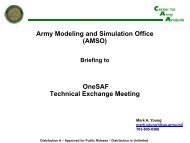
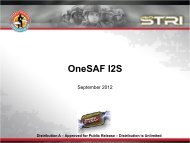
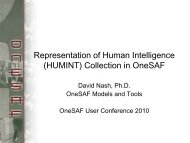
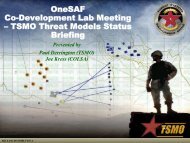
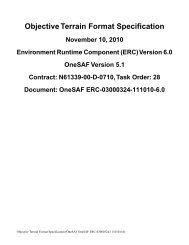
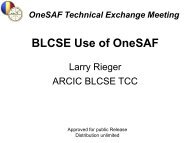

![2 R-Interoperability_Mechanisms.ppt [Read-Only] - OneSAF Public ...](https://img.yumpu.com/47020836/1/190x143/2-r-interoperability-mechanismsppt-read-only-onesaf-public-.jpg?quality=85)
